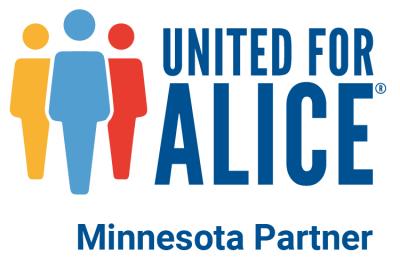
New ALICE report shows wage growth was no match for inflation after a decade of falling behind
RICE COUNTY, Minn. (Sept. 10, 2024) — Though wages for the lowest paid jobs have risen across the country at the fastest rate in four decades, the number of households struggling to get by in Minnesota grew from 2021 to 2022. As a result, a total of 834,343 households or 36 percent were living paycheck to paycheck, according to a new report, “ALICE in Minnesota: A Study of Financial Hardship,” from Rice County Area United Way, United Ways of Minnesota, and their research partner, United For ALICE. That calculation includes 233,779 Minnesota households in poverty as well as another 600,564 defined as ALICE.
ALICE ® is an acronym for Asset Limited, Income Constrained, Employed, and it’s a way of understanding families, neighbors, and colleagues who work hard, earn above the Federal Poverty Level, but don’t make enough to afford a basic household survival budget. ALICE workers include childcare providers, home health aides, cashiers, retail clerks, waiters, nonprofit professionals and others — those working low-wage jobs, with little or no savings and one emergency from poverty. As a member of the United Ways of Minnesota, Rice County Area United Way recently joined the United for ALICE network — a national movement to raise awareness about this growing but often hidden population in our communities.
In Rice County, 27% of households were ALICE in 2022, compared to the state average of 26%, and 14% of Rice County households were in poverty, compared to the state average of 10%. This means in Rice County, more households are struggling (9,821) per capita than the state average, with 42 percent below the ALICE Threshold.
ALICE in Minnesota: A Study of Financial Hardship shows that while wages were increasing, so too were costs. For a family of four with an infant and a preschooler, the basic costs to live and work in Minnesota, excluding tax credits, rose from $63,444 in 2021 to $77,304 a year later. Compounding the issue in 2022 was the loss of up to $15,000 in federal child tax credits and stimulus payments that this family had access to in 2021. In 2022, household costs in Rice County for a single adult ($27,888) and a family of four ($82,824) were well above the Federal Poverty Level of $13,590 and $27,750 respectively.
“There is no doubt, bigger paychecks helped, but inflation and the loss of pandemic supports converged to keep ALICE trapped,” said Rice County Area United Way Executive Director Elizabeth Child. “This latest data is a reminder that while we have made some progress, our work is far from over.”
The findings in this one-year period are consistent with a more than decade-long trend: Since the end of the Great Recession, despite some ups and downs, the number of ALICE households in Minnesota has been steadily growing. From 2010 to 2022, the total number of households rose by 10 percent, households in poverty increased by 1 percent — and the number of ALICE households grew by 33 percent.
“The data is showing persistent and widespread financial hardship — a red flag that the current system isn't working for ALICE,” said Stephanie Hoopes, Ph.D., United For ALICE National Director. “Current policy has not been enough to break down the barriers that trap ALICE households in financial hardship, from lack of access to housing and childcare that’s affordable, to inadequate community supports such as broadband internet."
Additional insights include:
- From 2010 to 2022, people age 65 and over made up the fastest-growing age group in Minnesota — and the group with the largest increase (44%) in the number of households struggling to make ends meet.
- Racial disparities persisted in the rates of financial hardship; 67% of Black, 60% of Hispanic and 50% of Asian households in Rice County were either in poverty or ALICE in 2022, compared to 32% of white households.
- Food assistance continued to elude many vulnerable families in Minnesota. Partly due to the SNAP income eligibility level in the state (200% of the Federal Poverty Level), only 32% of all Minnesota households in poverty and 13% of all ALICE households
participated in SNAP in 2022.
To read the report and access online, interactive dashboards that provide data on financial hardship at the state, county and local levels, visit UnitedForALICE.org/Minnesota.
